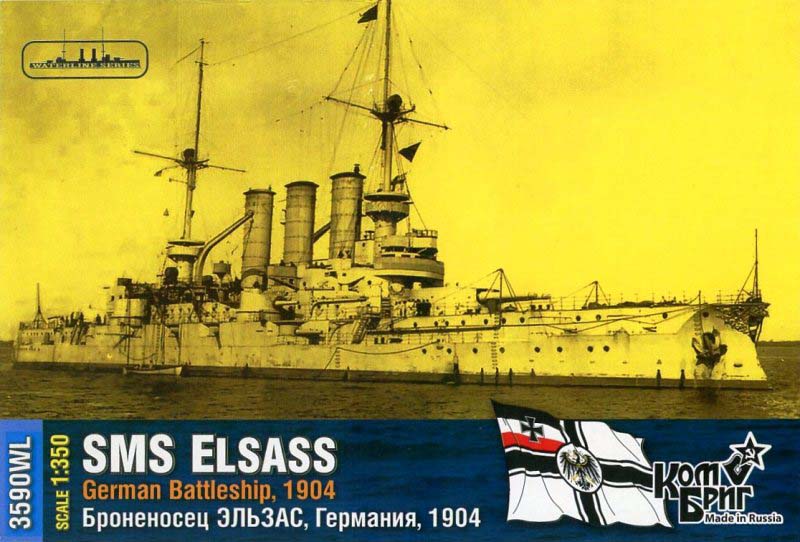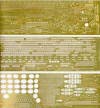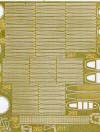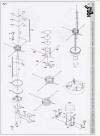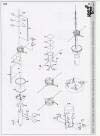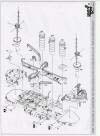|
|
|
The Combrig SMS Elsass
Elsass is packaged in a large, sturdy white cardboard box, with
a photo of the real vessel on the box top. Inside the box is an upper hull,
three bags with
over 270 resin parts, a package of turned brass parts, and 3 photo-etch frets.
The PE is firmly wrapped together and sandwiched between cardboard inserts for
protection. The box was tightly packed with foam to prevent shifting and
breakage of the contents.
|
|
|
| THE HULL |
|
|
As this is the waterline version of the kit, only the
upper hull is included. According to the measurements I found for
Elsass, the hull scales out
pretty much perfectly in both beam and length. The upper hull is very well cast with
lots of good detail, including chocks, bollards, skylights, hatches and the gun
port covers on the hull. The planking - no butt ends - looks good,
as does the linoleum on the boat and superstructure decks, though the groves
between the linoleum "panels" might be a tad too deep. There is some
over-pour on the bottom of the hull that will need to be removed. Compared
to drawings and photographs, the hull "looks" like a Braunschweig-class
battleship.
On the sides of the hull there are very small holes in
various locations. Looking closely at the instructions, these are
locating holes for the individual photo-etch ladder rungs included with the
extensive PE set. You'll find these locating holes on other parts of
the kit as well, including on the funnels and on superstructure bulkheads.
|
|
|
| TURRETS |
|
|
The Braunschweig-class battleships had two (larger)
main battery turrets and four (smaller) secondary turrets, for a total of six.
The turrets look the part, and are crisply cast, with sharp edges and subtle
hatches on the rear of the turrets. There is over-pour on the bottom
of all of the turrets, especially on the those secondary turrets, which you'll
have to remove beforehand. The resin gun barrels look good, with
open muzzles.
|
|
|
| FUNNELS |
|
|
There are three funnels included. As with everything
else, the casting is well done. They have a deep enough recess cast into
the top to give the impression of depth, and have small locating holes in the
funnel sides, to accommodate both the photo-etch ladder rungs and hand rails.
|
|
|
| SUPERSTRUCTURE
PARTS |
|
|
The superstructure parts include two large pieces, which
form the base of the forward and aft superstructures. There's a little bit
of a casting wafer on the bottom of each, so you'll have to sand that off to get
a good fit with the hull. Otherwise, nice details abound, with thin
splinter shields and other fine detail. Here too, you'll find the
small locating holes for the photo-etch. The rest of the
superstructure parts are on wafers. There is some terrific detail
cast into these parts, like vents and skylights.
|
|
|
| SHIPS BOATS |
|
|
There are a baker's dozen worth of boats in the kit. Two are powered.
The cutters all come with photo-etch parts to dress them up, the hulls are all
just resin shells. All are up
to the usual Combrig standards, which means they are well done. |
|
|
| ASSORTED
PARTS |
|
|
The remain resin includes a myriad of part: different
types of cranes, bases for the large boat cranes, boat davits, what appear to be
coaling davits, gun barrels and several smaller guns, deck and bridge equipment,
anchors, upper masts, searchlights and other parts, including the tops and
bottoms of the spotting tops. Everything is well cast. Some of the
parts are very delicate, and you'll need to very careful removing them from
their runners. Also included are the props and rudders, even though
this is the waterline version of the kit. The bases of the military
masts are worth highlighting, as it appears that they have stairs cast into the
openings at the tops of each mast! |
|
|
| TURNED METAL
PARTS |
|
|
There is a package of turned metal parts - made by Master
Model of Poland - included with the model. Among these are
replacements for the resin versions of the upper masts, as well as the main
batter and secondary battery barrels.
|
|
|
| PHOTOETCH |
|
|
There are three photo etch frets with the kit.
The list of parts is extensive. It
includes portholes, porthole shutters, decks, gun shields, funnel rings,
handrails (for the superstructure bulkheads, boat cradles, the bridge face,
inclined ladders, parts for the boats (both decks and thwarts), boat oars and
railings. There is also the bow scroll. Some of the parts are
relief etched.
There are no masts included with the kit, but, as per usual Combrig practice,
there are drawings showing dimensions of the masts and yards. Would
love to see Master Model (who supplied the aforementioned turned metal parts) do
a mast set for this ship.
The photo-etch set for this kit is very comprehensive,
but also, not for the beginner, as some of the PE is incredibly
small. The ladder rungs will be a challenge just to get off the fret, let
along attach to the model. |
|
|
|
|
| INSTRUCTIONS |
|
|
The instructions are some of the best I've seen from Combrig. There are
14 sheets of paper, with instructions on each sides. Along with a plan
and profile view of Elsass, there is a parts manifest, a page showing the
"self-made" masts, and then an comprehensive set of instructions with exploded
views. For such a complex kit as this one, the improved instructions
are good to see.
There are no color callouts or painting instructions.
|
|
|
| CONCLUSIONS |
|
The Combrig Elsass is is an
excellent kit of one of the lesser known ships of the Kaiserliche Marine.
It's fabulously cast (is there a resin ship manufacturer consistently
doing casting better than Combrig right now?), with an extensive photo-etch set,
turned brass parts, well laid out and comprehensive instructions. Except
for masts, it's got all you need to spend hours and hours (months and months?)
building it. Glad to see the continuing improvement in both the
instructions and how Combrig packages their kits. Highly recommended
- but for experienced modelers only. Now, if we could only coax
Combrig to do an SMS Nassau....
This is Combrig’s 1/350 SMS Elsass, kit number 3590WL. The model is available
online, from many of our fine sponsors, starting at around $335.00.
This is an in-box
review, your mileage may vary once you commence construction. Thanks to Combrig
Models for the review sample. |
 |
